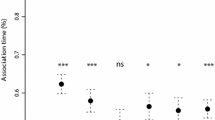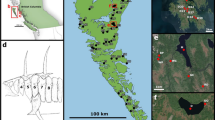Abstract
Threespine sticklebacks (Gasterosteus aculeatus) from different habitats have been observed to differ in shoaling behavior, both in the wild and in laboratory studies. In the present study, we surveyed the shoaling behavior of sticklebacks from a variety of marine, lake, and stream habitats throughout the Pacific Northwest. We tested the shoaling tendencies of 113 wild-caught sticklebacks from 13 populations using a laboratory assay that was based on other published shoaling assays in sticklebacks. Using traditional behavioral measures for this assay, such as time spent shoaling and mean position in the tank, we were unable to find population differences in shoaling behavior. However, simple plotting techniques revealed differences in spatial distributions during the assay. When we collapsed individual trials into population-level data sets and applied information theoretic measurements, we found significant behavioral differences between populations. For example, entropy estimates confirm that populations display differences in the extent of clustering at various tank positions. Using log-likelihood analysis, we show that these population-level observations reflect consistent differences in individual behavioral patterns that can be difficult to discriminate using standard measures. The analytical techniques we describe may help improve the detection of potential behavioral differences between fish groups in future studies.




Similar content being viewed by others
References
Bell MA, Foster SA (1994) The evolutionary biology of the threespine stickleback. Oxford University Press, Oxford
D'Agostino RB, Pearson ES (1971) An omnibus test of normality for moderate and large sample size. Biometrika 58:341–348
D'Agostino RB, Pearson ES (1973) Tests for departure from normality. Biometrika 60:613–622
Frommen JG, Bakker TCM (2004) Adult three-spined sticklebacks prefer to shoal with familiar kin. Behaviour 141:1401–1409
Jones E, Oliphant T, Peterson P (2001) SciPy: Open source tools for Python
Kozak GM, Boughman JW (2008) Experience influences shoal member preference in a species pair of sticklebacks. Behav Ecol 19:667–676
Krause J, Ruxton GD (2002) Living in groups. Oxford University Press, Oxford
Magurran AE (1990) The inheritance and development of minnow antipredator behaviour. Anim Behav 39:834–842
Magurran AE, Seghers BH (1991) Variation in schooling and aggression amongst guppy (Poecilia reticulata) populations in Trinidad. Behaviour 118:214–234
Magurran AE, Seghers BH, Carvalho GR, Shaw PW (1992) Behavioural consequences of an artificial introduction of guppies (Poecilia reticulata) in N. Trinidad: evidence for the evolution of anti-predator behaviour in the wild. Proc Biol Sci 248:117–122
Magurran AE, Seghers BH, Shaw PW, Carvalho GR (1995) The behavioral diversity and evolution of guppy, Poecilia reticulata, populations in Trinidad. In: Advances in the study of behavior. Academic Press Limited, London, pp 155–155
Paninski L (2003) Estimation of entropy and mutual information. Neural Comput 15:1191–1253
Parzefall J (1993) Behavioural ecology of cave-dwelling fishes. In: Pitcher TJ (ed) Behaviour of teleost fishes. Chapman and Hall, London, pp 573–608
Parzen E (1962) On estimation of a probability density function and mode. Ann Math Stat 33:1065–1076
Pitcher TJ, Parrish JK (1993) Functions of shoaling behaviour in teleosts. In: Pitcher TJ (ed) Behaviour of teleost fishes. Chapman & Hall, London, pp 369–439
Seghers BH (1974) Schooling behavior in the guppy (Poecilia reticulata): an evolutionary response to predation. Evolution 28:486–489
Shannon CE (1948) The mathematical theory of communication. Bell Syst Tech J 27:379–423
Timmermann M, Schlupp I, Plath M (2004) Shoaling behaviour in a surface-dwelling and a cave-dwelling population of a barb Garra barreimiae (Cyprinidae, Teleostei). Acta ethologica 7:59–64
Vamosi SM (2002) Predation sharpens the adaptive peaks: survival trade-offs in sympatric sticklebacks. Ann Zool Fenn 39:237–248
Victor JD (2002) Binless strategies for estimation of information from neural data. Phys Rev E 66:51903
Ward AJ, Hart PJ, Krause J (2004) Assessment and assortment: how fishes use local and global cues to choose which school to go to. Proc Biol Sci 271:S328–S330
Wright D, Krause J (2006) Repeated measures of shoaling tendency in zebrafish (Danio rerio) and other small teleost fishes. Nat Protoc 1:1828–1831
Wright D, Rimmer LB, Pritchard VL, Krause J, Butlin RK (2003) Inter and intra-population variation in shoaling and boldness in the zebrafish (Danio rerio). Naturwissenschaften 90:374–377
Wright D, Nakamichi R, Krause J, Butlin RK (2006) QTL analysis of behavioral and morphological differentiation between wild and laboratory zebrafish (Danio rerio). Behav Genet 36:271–284
Acknowledgments
We would like to thank Matt Arnegard, Susan Foster, Andrew Hendry, Jean-Sebastien Moore, Dolph Schluter, and Mike Shapiro for their help in collecting sticklebacks, and to Anna Greenwood for the advice and support throughout the study. We are also grateful to Adrienne Fairhall and Joe Sisneros for their helpful comments on the manuscript. This research was supported by a grant from the National Institutes of Health HG002568 to C.L.P.
Author information
Authors and Affiliations
Corresponding author
Additional information
Communicated by J. Krause
Electronic supplementary materials
Below is the link to the electronic supplementary material.
Fig. S1
Tracked fish positions are correlated in time in both horizontal and vertical dimensions for approximately 60 s, the width of the correlation peak at half-maximum. a Auto-correlation function shows correlation coefficient between each fish's horizontal position in the tank and that fish's horizontal position at a given time lag (thin gray lines). Average auto-correlation across all 113 fish is shown in bold. b Auto-correlation function shows correlation coefficient between each fish's vertical position in the tank and that fish's vertical position at a given time lag (thin gray lines). Average auto-correlation across all 113 fish is shown in bold (PDF 1404 kb)
Rights and permissions
About this article
Cite this article
Wark, A.R., Wark, B.J., Lageson, T.J. et al. Novel methods for discriminating behavioral differences between stickleback individuals and populations in a laboratory shoaling assay. Behav Ecol Sociobiol 65, 1147–1157 (2011). https://doi.org/10.1007/s00265-010-1130-x
Received:
Revised:
Accepted:
Published:
Issue Date:
DOI: https://doi.org/10.1007/s00265-010-1130-x




